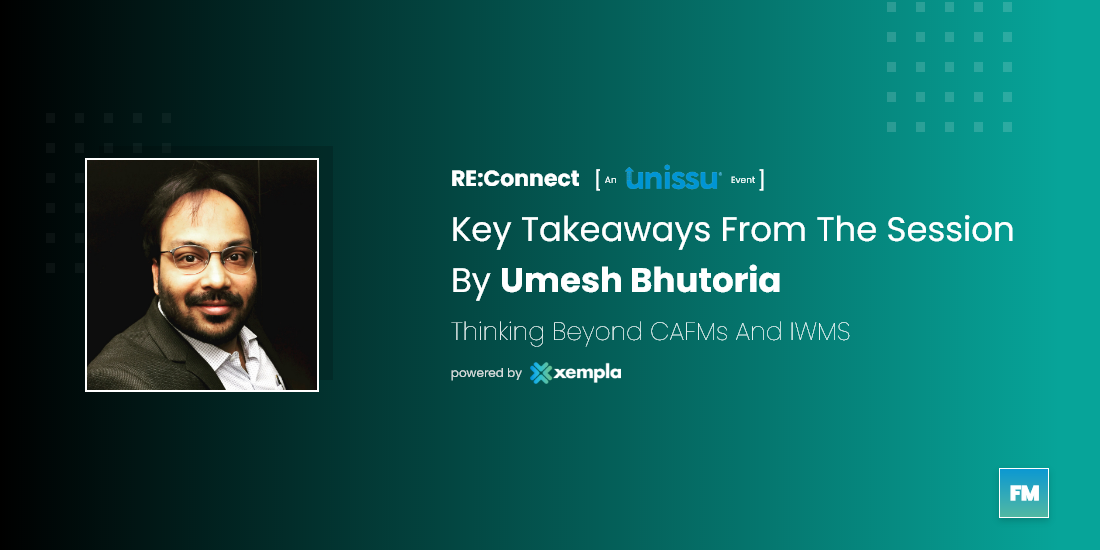Whenever we talk about the Facility management software, the first and foremost thing that comes to mind is the CAFM system, in a transition from in-house asset management to asset consolidation and then outsourcing for the Integrated asset and facility management, CAFMs systems have also evolved or rather created whole new categories such as CMMS and IWMS.
In the past couple of years, we have seen boundaries of CAFM and CMMS are getting wider and in some places getting overlapped as property owners or FM teams are using it for work order management as well as monitoring critical assets. And as a requirement for the integration grew up we facilities started relying on the IWMS platform which basically brings in all the different aspects of facility management on a single platform and provides 3rd party plug-in applications to utilize the centralized data sources to provide a unified property view.
Umesh Bhutoria in his session on ‘Moving beyond CAFM and CMMS’ highlighted the transition facility management firms are going through and suggested ways to prepare to maintain their edge over competitors.
What’s next IWMS+ or IWMS 2.0
Since Gartner published the first magic quadrant on IWMS in 2004, we have seen humongous changes in terms of communication devices, data processing capacities, analytics, and a completely different set of tenant’s expectations.
So to highlight the change:
- The need for granular level occupants data has increased
- Addition of multiple IoT platforms/applications
- The structure of Operations and maintenance contracts have evolved from resource to performance-driven.
Umesh ponders on this question whether we still need to search for IWMS+ or IWMS 2.0? One that is an extension of the original version or the completely net set of tesh stack.
FM can’t leave technology to service providers
Now if I look at the current state of data management in facilities there are multiple stakeholders involved to manage it. From property owners to 3rd party application vendors everyone owns the piece of pie and that’s going to be there for a long time. One simply can not command the entire data architecture and that’s good for all.
There are big and small technology companies that are trying to get into the picture by offering exclusivity or cost-efficient solutions and trying to build the tech ecosystem around their solutions. They can be a serious threat to facility management firms if they still operate in BAU conditions.
Need to rethink on Technology stack
With all the complexity of various stakeholders involving in the data and software landscape at different capacities, FM’s have three options to move forward:
- Cant survive if betting on a lower price
- Integrate Energy management, sustainability into the product portfolio
- Strategic involvement with business heads to get new business opportunities into M&V, Project manager, etc

Umesh Highlighted that the differentiator becomes how you use the technology with your team and the processes.
Now with the changing structure of contracts are getting signed, addon focuses on sustainability and energy efficiency targets as well as the availability of the cost-effective technology to acquire, process, and interpret complex data sources facility management firms to need to prepare their tech stack which can be flexible enough to serve various types of buildings and at the same time scalable enough to help teams build on it in the future.
Way forward?
To conclude the session Umesh suggested there are three ways a strategic team can plan for the change without disturbing the original business processes.
Making the stack a part of the service delivery model
- Instead of waiting for the client to come up with the request, FMs should include it as a part of SDM with a calculated risk. Take 2-3 sites and make trials possibles
Challanges BAU process
- Until you get the confidence on the stack or SDM run a parallel challenger process with BAU, run it for 10-12 months then evaluate both based on effort, impact, and economics and then move ahead with the right one.
Long Term ROI:
- Short term RoI does not need to hold back any of your Challenger BAU processes. Let it run for the longer-term ROI
Now you might have several questions in your mind, How to plan for the Challenger BAU process, where to start for the trials, and what aspects should be looked into?
Well for all those questions you can refer to our ebook on planning and executing Asset performance management trials. Or you can schedule a call with Umesh Bhutoria (Founder, CEO Xempla) to learn more about it.

Leave a Reply